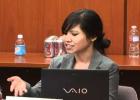Advanced Contracts
Many of us have come to law teaching thinking that our job is to be the expert at the front of the class imparting information. But one of the most important things we can do for our students is to get them actively engaged in problem-solving together to generate workable solutions to client problems. As I see it, my job as a professor is to design the materials and opportunities for them to do that and then to take myself out of center stage as much as possible. Students learn a great deal more from testing out their own ideas about law and doing the work of a lawyer, seeing how their ideas work out than they do from being told by an expert what the ‘right’ answer is. The ‘right’ answer is gone tomorrow; the experience of finding and recognizing good answers by thinking, risking, observing, revising, and trying again stays with them.
32 students per semester
First time administration of the course: Spring 1997
Most recent administration of the course: Fall 2009
This course has been taught eight times.
This is an upper level course that deepens students' understanding of contract law principles and their capacity to deploy them in the context of solving practical problems that involve contracting relationships. The course is taught entirely through team-based, case-based analysis and is experiential.
My course materials consist exclusively of case-study materials; students are required to do any research they judge necessary (and feasible) – whether it involves contract law or other areas of law. The course develops transactional reasoning and analysis that goes beyond “contract” law. This course approach gives students repeated opportunities to frame a client’s problem and exercise judgment about how to establish priorities in legal work. Moreover, students develop strategic advice, which requires developing a mental map for how to learn about business objectives and integrate them with legal analysis. Students rotate into the ‘client’ role to develop their appreciation for what is, and what is not, helpful legal analysis. Finally, the course requires students to significantly exercise and develop their oral and written communication skills to develop and convey legal analysis. Students assume almost complete responsibility for the in-class discussions.
This course differs from traditional doctrinal courses that emphasize the content rather than deployment of legal rules. It maps all three Carnegie apprenticeships: students acquire new and develop prior substantive knowledge of legal rules; they deploy legal knowledge in an immersive setting that mimics varied professional settings (operational design, negotiation, dispute resolution, arbitration, adjudication); and they learn about managing various roles including relationships with other professionals and clients.
Students work in teams of four throughout the semester. There are eight case studies, each based on an actual client problem and often drawing on actual (redacted) documents. Teams complete four cases as “attorney teams” and work on the remaining four as “clients.”
The case studies present a scenario and problem as well as a role for the attorney. Students are asked to develop advice for the client. They are not told what issues to focus on or materials to use: these are the primary tasks that engage them.
There are 3 classes for each case. In the first, teams discuss topics outlined by each group the night before; class discussion is conducted by the students, with groups taking turns as ‘chair’ of the discussion. For the second class, attorney teams produce a memo outlining their analysis and recommendations for the client; these are posted the night before the second class, and then discussed. As before, class discussion is conducted by the students, with groups taking turns as ‘chair.’ In a third class, the instructor debriefs the case, to explore issues that were left unresolved or confused and provide more facilitated analysis. Memos are marked up extensively by the instructor and posted for all students to read (without the grades).
The goals of the course are to develop judgment and an understanding of how legal knowledge is deployed in practice. Students come to appreciate how integral legal analysis is in business decision making, how to identify and assess risks as well as how to go from legal abstract rules to practical solutions. Students also learn to behave professionally in teams and to communicate with other professionals and clients.
In the original design of this course, there were substantial theoretical assigned readings and lectures. In early iterations, however, it became clear that even advanced upper year law students did not understand the task of the lawyer when presented with a realistic legal assignment; moreover their knowledge of basic contract principles was thin. These experiences made it clear that there is a major gap between discussing strategic considerations with students and allowing them to gain actual experience through repeat trial and error. The course thus evolved to focus exclusively on developing the understanding of what lawyers do in practice.
Evaluation is exclusively based on the work done on case studies. Case memos receive detailed written feedback and are graded on a group basis out of 20. All students in the group receive the same score and students are free to choose any way of managing their group that they like, but each person in the group must be identified as point person for a memo. For the four cases on which a group serves as client, the group is required to prepare a one-page commentary on the analysis they received; each person in the group is required to take a turn serving as point person for the preparation of that commentary. Client comments are not expressly critiqued or graded, although they are shared with the entire class.
Group-based grades on memos count for 60% of the final grade; I drop the lowest of the four memo scores. I assign 20 points at the end of the semester to the groups based on quality of client comments and 20 points individually for contributions to the group and class discussions, paying close attention to group submissions for which that individual served as point person.
I have found that sharing individual points with students during the course demoralizes the groups and creates conflict; so these points are only awarded after the course is finished. There is no final exam. Students complete a peer- and self-evaluation form at the end of each attorney memo in which they can reflect on their experiences working on the case—what they learned, what they struggled with—as well as discuss the working of their group. Group members then assign a share of 100 points to each group member, including himself or herself; these scores inform but do not feed directly into the individual scores awarded at the end of the semester. I find these forms and this mechanism provide students with an important way of managing frustrations with group experiences and provide me with a method for identifying group problems that I might want to address directly with the groups or individuals involved, though this happens rarely. I make myself available to mediate group conflicts, but this also happens rarely.
This course requires the instructor to step out of the role of providing information and to shift responsibility to students for all aspects of the course. The cases, being real client problems, are not vehicles for the instructor to demonstrate a pre-determined point; they are vehicles for students to practice solving problems. This will often result in the students missing issues a more expert analyst would see, but they learn from having missed it and it becomes a lesson even more important than the substantive issue presented in a particular legal problem.
Some discover they missed key considerations because their group was dominated by a single person who had a pet idea. Others discover they were still reacting to the cases as if they were students being asked to guess what the professor wants to hear. Others still find they never really realized there was more to the job than listing sets of issues and stating abstract rules—that it was up to them to figure out how to solve the problem and that a lot turned on how well they did that.
This experiential approach requires the instructor to resist his or her own inclination to be smart and in control, and to resist entreaties and criticism from students who believe it is the instructor’s job to point them to the important material. The instructor cannot be the focus of the discussion or the funnel through which discussion is conducted.
Class discussions, for example, can easily become unfocused and head off on tangents and students early in the course can be critical of the instructor who does not get everyone back on the main points. The message for the students to hear, however, is that they are responsible for the final outcome so it is their job to recognize when discussion is becoming unproductive and to refocus it.
This is a critical way in which they develop legal judgment, as well as professional attitudes and competence in team and client meetings. I take a more active role in early classes to model this, but as the course progresses my goal is to say nothing. The course also requires the instructor to be willing to give detailed and critical, but balanced, written feedback on student memos. It is important to recognize that this work is now the main teaching work in the course. For discussion classes, there is almost no class preparation beyond reading the case and the memos and outlining a few ideas; preparation for the debriefing class is also largely done as a byproduct of evaluating the memos groups submit. There is no final exam. I find this course is generally less work for a professor than an upper year doctrinal course.
The evidence of effectiveness in this course comes from the evolution of students’ abilities to understand and execute the task of analyzing a client’s problem and produce a recommended approach to solving it. Early memos tend to look like the research memos we train students to write in first year: they spot many issues, they state abstract rules, but they do not start the hard work of making critical judgments about which problems or issues to focus on, and how to go from abstract rule to situated analysis and recommendations.
Students also develop a practical understanding of what counts as "business judgment" and what counts as "legal judgment" by someone who understands the business problem and what will affect business judgment. Class discussions also evolve significantly over time as students assume confidence in taking responsibility for the flow and productivity of discussion. Whereas in early classes, I may need to intervene a number of times to jumpstart discussion, model critique, or encourage students to respond directly to the point on the table or talk to the person who made the point (not me), by mid-semester I can largely stay out of discussion. Students also report success in figuring out how to better manage team relationships.
Students complete detailed course evaluation forms that ask them to reflect on the cases and what they learned; they are also asked to prepare a chart rating their competence on several abilities such as exercising judgment, communicating clearly, understanding contract principles, comparing what they think they were capable of before and after the course; these forms consistently identify the areas that students experience the greatest increase in competence—particularly focusing on the big picture, exercising judgment, communicating succinctly, and so on. The best evidence of effectiveness comes in end-of-year reflections that I ask students to write. Students are effusive about how the course turns on the lightbulb of understanding what it means to ‘be’ a lawyer.


